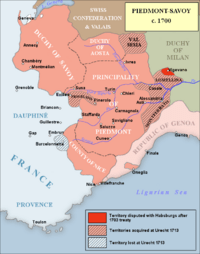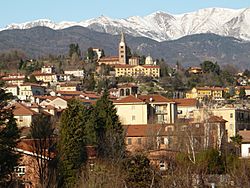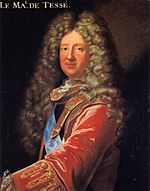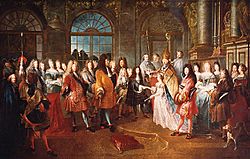Treaty of Turin (1696) facts for kids
| The Acts and Negotiations of the Peace concluded between the French King and the Duke of Savoy. | |
|---|---|
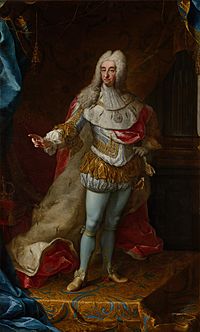
Victor Amadeus, Duke of Savoy
|
|
| Context | Savoy leaves the Grand Alliance and makes a separate peace with France |
| Signed | 29 August 1696 |
| Location | Turin |
| Parties | |
The Treaty of Turin was signed on August 29, 1696. It was an agreement between the French King and the Duchy of Savoy. This treaty officially ended Savoy's part in the Nine Years' War.
Savoy made a separate peace deal with France. This meant they left the Grand Alliance. The Grand Alliance was a group of countries against France. It was formed in 1689 by England, the Dutch Republic, and Emperor Leopold.
After the Treaty of Turin, another agreement was made. On October 7, 1696, France, Savoy, Leopold, and Spain signed the Convention of Vigevano. This agreement created a general ceasefire in Italy. The Treaty of Turin later became part of the 1697 Treaty of Ryswick.
Why the Treaty of Turin Was Needed
Northern Italy was very important because it led to the southern borders of France and Austria. This made areas like the Duchy of Milan and the Duchy of Savoy key for safety. In 1631, France took over Pinerolo in Piedmont. They also controlled Casale Monferrato. Much of the Duchy of Savoy, including Nice and Savoy, is now part of modern France. Savoy was seen as a small power, almost like a country controlled by France.
The Nine Years' War (1688-1689) was fought between France and a group of countries called the Grand Alliance. Savoy was important in this war for two main reasons. France had strong defenses in the north, but its southeastern borders were weak. Also, a rebellion by French Protestants called Huguenots (the Camisards) in southwestern France offered a chance for other countries to get involved. This rebellion started after the 1685 Edict of Fontainebleau, which took away their rights.
In 1690, the Allies started to get support for the Camisards. They also looked for help from the "Vaudois," Protestants living in what is now Swiss Canton of Vaud. Both Savoy and France had treated these groups badly. By the summer of 1690, it was clear that Savoy would have to pick a side in the war.
Faced with this choice, the Duke of Savoy, Victor Amadeus, stopped treating the Vaudois badly. He then joined the Alliance. His main goal was to get back Pinerolo and Casale. These places were very important because they controlled access to his capital city, Turin. In August 1690, a French army led by Nicolas Catinat defeated Savoy's army at Staffarda.
Savoy was almost completely taken over by France in late 1691. But reinforcements from Spain, Bavaria, and Brandenburg-Prussia saved them. In 1692, Victor Amadeus briefly invaded the Dauphiné region of France. This was the only time the Allies entered French land during the whole war.
The war was very expensive for everyone involved, especially France. France was almost bankrupt because it was fighting the Grand Alliance alone. Between 1693 and 1695, there were also bad harvests in France and northern Italy. This caused a widespread famine, and Piedmont was one of the worst-hit areas.
In October 1693, Savoy lost a second battle at Marsaglia. This battle didn't change the war much, but it showed that a clear victory over France was still far away after three years of fighting. In late 1694, Emperor Leopold I told Victor Amadeus his main goal for 1695 was Casale. Leopold claimed Casale belonged to his empire. If the French soldiers were replaced by Imperial ones, it wouldn't help Savoy.
France offered peace terms to the Allies in November 1694. These terms did not mention Pinerolo. When asked, French diplomats said they would not give it up. This was probably a trick by Louis XIV to divide the Allies. But it meant Savoy might lose both of its main goals. Because Leopold didn't give firm promises, Victor Amadeus started secret talks with France in 1693.
France secretly agreed to give Casale to Savoy if its defenses were destroyed. After a small fight, Casale surrendered in early July, and Victor Amadeus took control. The Allies became more suspicious but agreed to attack Pinerolo.
To keep the talks secret, the negotiations were handled by two people. The French commander at Pinerolo, the Comte de Tessé, represented Louis XIV. Savoy's top diplomat, Carlo Giuseppe Vittorio Carron, Marquis de St-Thomas, represented Savoy.
What the Treaty Said
All lands in Savoy that France had taken would be given back. This included Pinerolo, but its defenses had to be destroyed first. Savoy also had to stop its Protestants from helping the French Camisard rebels. Victor Amadeus's longtime French mistress, Jeanne Baptiste d'Albert de Luynes, helped arrange a marriage. His oldest daughter, Marie Adélaïde of Savoy, would marry Louis XIV's grandson, the Duke of Burgundy.
This marriage made Savoy more important in Europe. Many deaths in the French Royal Family meant that Marie Adélaïde's younger son would become King Louis XV in 1715.
The terms were agreed by the end of June. But the treaty was not signed until August 29. This delay allowed Bavaria, Brandenburg-Prussia, and Spain to remove their soldiers from the forces outside Pinerolo.
What Happened Next
One part of the treaty caused a lot of discussion and hurt Savoy's reputation. Savoy agreed to help France force its former Allies to agree to a truce. In September 1696, a combined army from Savoy and France attacked Valenza. Valenza was then part of the Duchy of Milan. On October 7, France, Savoy, Emperor Leopold, and Spain signed the Convention of Vigevano. This agreement created a ceasefire. The war officially ended with the 1697 Treaty of Ryswick, which included the Treaty of Turin.
By leaving the Allies, Savoy's decision might have helped Louis XIV get better terms at Ryswick. This happened at a relatively small cost for France. France gave up Pinerolo. However, Savoy's lands in France were hard to defend. France took them over again from 1704 to 1714.
Victor Amadeus reached his main goals of getting back Pinerolo and Casale. His daughter's marriage also made Savoy more important in Europe. But the cost was a country that was ruined and poor. Victor Amadeus also gained a reputation for being self-interested. This made his former allies angry, and he didn't gain the friendship of Louis XIV either.
Being self-interested was not just limited to Victor Amadeus. His allies found Leopold and his successors frustrating too. Britain's decision to leave the War of the Spanish Succession in 1712 also caused problems. But this idea of Savoy being self-interested was strengthened when Savoy switched sides again in 1703. They left France and rejoined the Grand Alliance.
Sources
- Jacques, Bernard; The acts and negotiations, together with the particular articles at large of the general peace, concluded at Ryswick, by the most illustrious confederates with the French king to which is premised, the negotiations and articles of the peace, concluded at Turin, between the same prince and the Duke of Savoy; (http://name.umdl.umich.edu/A27483.0001.001)


